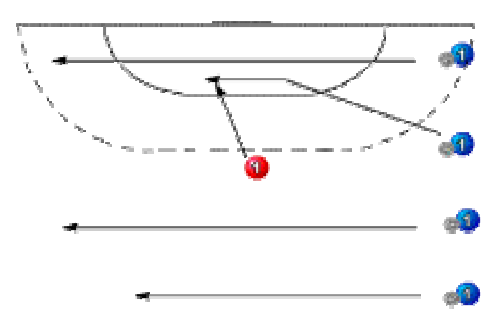Handball drills
- One person on the left side of the pitch (can also be another position) and this person has to shoot as many balls at the goal as possible within 1 minute (or longer).
- The rest of the players collect balls and one of them plays the balls to the ball.
- Shooting the link-up in succession.
- Keep track of how many times the player has scored.
- When you have shot, you must walk backwards to your position. Keep changing until everyone has been there.
Variation:
- Different ways of approaching (i.e. slightly inwards or outwards etc.)
- Different shots (underhand throw, bend throw, out of the way, etc.)
- Use more than 1 position

- Green passes 2 - 1 - 2 and shoots at goal.
- After throwing on goal you are handball
- 3-1-3 and shoot at goal.
Also useful for playing into the goalkeeper:
- On the hands
- Top corner left / right
- Shoulder height left / right
- Knee height left / right
- Bouncing balls left / right
- Low balls left / right

- Green passes 2 - 1 - 2 and shoots at goal.
- after throw on goal you are handball player, after handball you are goalie
- 3-1-3 and shoot on goal.

- Blue crosses over,
- Red must try to get rid of the ball.
- Ball away? -> defend until everyone has lost their ball.
- Too easy?
- Extra defenders.
- 3 times a ticker,
- whoever catches the balls in the shortest time is the winner.

- 2 tjoeks, in the corners of a half field, surrounding it with a circle of pawns.
- They are not allowed to enter.
- They are not allowed to tip (bounce). 2 teams.
- They score a point by throwing the ball into the corner of the circle and another player of the team catches the ball.
- The teams may score in both tjoos. Man-to-man defense.
- So let them make two teams and then one of the 2 vests and then they can defend each other.
- Hands, high, low, the kids know it.
- But now instead of going to get their ball right away.
- They leave their ball on the ground and sprint to the middle line after throwing the ball.
- balls all at the center line
- They make 2 teams.
- They all stand in 1 of the 2 corners.
- Then you bounce a ball and they have to move to the goalpost and sprint to you.
- Then you can for example roll the ball away, bounce it.
- Or just hold it and see who gets it first.
- What I often do when 1 person is left, then I let that person catch the balls and keep indicating
- Penalty's also called penalty throw.
- Make sure the foot is not on or over the line and that they leave it there.
- 2 teams play against each other.
- there are 3 pins on the field
- 2 in opposite corners on the same longitudinal line and
- 1 on the other longitudinal line so that these 3 cones form a triangle)
- score by tapping a cone
- after tapping a cone move directly to another cone
- extra rule:
- by good contact the ball is for the defender.
- there are 3 pins on the field
- 3 attackers and 3 defenders (later change)
- 3 defenders outside the 9m in "Liegestütz" (until the attackers sprint towards the 9m, then stand up)
- 3 attackers divided on LO, MO, RO
- 3 attackers sprint to the 9m and back to the half way line, then receive the ball and play 3:3.
- 3x in a row and then change
- Place two hoops in a row on either side.
- Player 1 stands in the last hoop on the left.
- Player 2 goes into the back hoop on the right. Stand with your knees bent.
- Try to throw the ball into the front hoop of the opponent with an underhanded movement (with two hands).
- If the ball touches the ground inside the hoop, you get 1 point.
- 3 pawns,
- 1 pawn on the circle=A,
- 1 pawn on the LO=B,
- 1 pawn on RO=C /
- if more players present, work with 4 pawns
- players divide into 3 groups and each group will stand behind 1 pawn
- start with 1 ball
- players at pion A have the ball and play to B and follow the pass (walk to pion B)
- player with pawn B receives the ball and plays the ball to player with pawn C and follows the pass (walk to pawn C)
- player near pawn C receives the ball and plays the ball to player near pawn A and follows the pass (walk to A)
- DUS play to the right and walk to the right
- 2nd heavier possibility:
- 2nd ball in reception OR play ball to the right and walk to the left








